Spatiotemporal Variation of Cold Eddies in the Upwelling Zone off Northeastern Taiwan Revealed by the Geostationary Satellite Imagery of Ocean Color and Sea Surface Temperature
Abstract
1. Introduction
2. Materials and Methods
2.1. Study Area: The Upwelling Zone off Northeastern Taiwan
2.2. Satellite Observations
2.3. Data Processing
3. Results and Discussion
3.1. Temporal Variation
3.2. Spatial Variations
3.3. Influence from Kuroshio
3.4. Influence of Typhoons
3.5. Suggestions for Future Work: Influence from El Niño and La Niña Events
4. Conclusions
Author Contributions
Funding
Acknowledgments
Conflicts of Interest
References
- Tansley, C.E.; Marshall, D.P. Flow past a cylinder on a β plane, with application to gulf stream separation and the antarctic circumpolar current. J. Phys. Oceanogr. 2001, 31, 3274–3283. [Google Scholar] [CrossRef]
- Toda, T. Movement of the surface front induced by kuroshio frontal eddy. J. Geophys. Res. Oceans 1993, 98, 16331–16339. [Google Scholar] [CrossRef]
- Hsu, S.C.; Lin, F.J.; Jeng, W.L.; Tang, T.Y. The effect of a cyclonic eddy on the distribution of lithogenic particles in the southern east china sea. J. Mar. Res. 1998, 56, 813–832. [Google Scholar] [CrossRef]
- Chen, Y.L.L.; Chen, H.Y.; Jan, S.; Lin, Y.H.; Kuo, T.H.; Hung, J.J. Biologically active warm-core anticyclonic eddies in the marginal seas of the western pacific ocean. Deep Sea Res. Part I Oceanogr. Res. Pap. 2015, 106, 68–84. [Google Scholar] [CrossRef]
- Wada, A. Reexamination of tropical cyclone heat potential in the western north pacific. J. Geophys. Res. Atmos. 2016, 121, 6723–6744. [Google Scholar] [CrossRef]
- Sukigara, C.; Suga, T.; Toyama, K.; Oka, E. Biogeochemical responses associated with the passage of a cyclonic eddy based on shipboard observations in the western north pacific. J. Oceanogr. 2014, 70, 435–445. [Google Scholar] [CrossRef]
- Liu, C.-C.; Shieh, C.-L.; Lin, J.-C.; Wu, A.-M. Classification of non-vegetated areas using formosat-2 high spatiotemporal imagery: The case of tseng-wen reservoir catchment area (taiwan). Int. J. Remote Sens. 2011, 32, 8519–8540. [Google Scholar] [CrossRef]
- Hosoda, S.; Nonaka, M.; Sasai, Y.; Sasaki, H. Early summertime interannual variability in surface and subsurface temperature in the north pacific. J. Oceanogr. 2015, 71, 557–573. [Google Scholar] [CrossRef]
- Smirnov, D.; Newman, M.; Alexander, M.A.; Kwon, Y.O.; Frankignoul, C. Investigating the local atmospheric response to a realistic shift in the oyashio sea surface temperature front. J. Clim. 2015, 28, 1126–1147. [Google Scholar] [CrossRef]
- Hsu, S.C.; Lin, F.J.; Jeng, W.L.; Tang, T.Y. Spatial distribution of cadmium over a cyclonic eddy in the southern east china sea. J. Mar. Syst. 2003, 39, 153–166. [Google Scholar] [CrossRef]
- Frenger, I.; Gruber, N.; Knutti, R.; Munnich, M. Imprint of southern ocean eddies on winds, clouds and rainfall. Nat. Geosci. 2013, 6, 608–612. [Google Scholar] [CrossRef]
- Sasaki, Y.N.; Minobe, S. Climatological mean features and interannual to decadal variability of ring formations in the kuroshio extension region. J. Oceanogr. 2015, 71, 499–509. [Google Scholar] [CrossRef]
- Revelard, A.; Frankignoul, C.; Sennechael, N.; Kwon, Y.O.; Qiu, B. Influence of the decadal variability of the kuroshio extension on the atmospheric circulation in the cold season. J. Clim. 2016, 29, 2123–2144. [Google Scholar] [CrossRef]
- Shih, Y.Y.; Hung, C.C.; Gong, G.C.; Chung, W.C.; Wang, Y.H.; Lee, I.H.; Chen, K.S.; Ho, C.Y. Enhanced particulate organic carbon export at eddy edges in the oligotrophic western north pacific ocean. PLoS ONE 2015, 10, e0131538. [Google Scholar] [CrossRef] [PubMed]
- Lu, W.F.; Yan, X.H.; Jiang, Y.W. Winter bloom and associated upwelling northwest of the luzon island: A coupled physical-biological modeling approach. J. Geophys. Res. Ocean. 2015, 120, 533–546. [Google Scholar] [CrossRef]
- Cabrera, O.C.; Villanoy, C.L.; Alabia, I.D.; Gordon, A.L. Shifts in chlorophyll a off eastern luzon, philippines, associated with the north equatorial current bifurcation latitude. Oceanography 2015, 28, 46–53. [Google Scholar] [CrossRef]
- Zainuddin, M.; Kiyofuji, H.; Saitoh, K.; Saitoh, S.I. Using multi-sensor satellite remote Sens. and catch data to detect ocean hot spots for albacore (thunnus alalunga) in the northwestern north pacific. Deep Sea Res. Part II Top. Stud. Oceanogr. 2006, 53, 419–431. [Google Scholar] [CrossRef]
- Dupouy, C.; Neveux, J.; Ouillon, S.; Frouin, R.; Murakami, H.; Hochard, S.; Dirberg, G. Inherent optical properties and satellite retrieval of chlorophyll concentration in the lagoon and open ocean waters of new caledonia. Mar. Pollut. Bull. 2010, 61, 503–518. [Google Scholar] [CrossRef]
- Miller, R.L.; Liu, C.-C.; Buonassissi, C.J.; Wu, A.-M. A multi-sensor approach to examining the distribution of total suspended matter (tsm) in the albemarle-pamlico estuarine system, nc, USA. Remote Sens. 2011, 3, 962–974. [Google Scholar] [CrossRef]
- Shanmugam, P. New models for retrieving and partitioning the colored dissolved organic matter in the global ocean: Implications for remote Sensing. Remote Sens. Environ. 2011, 115, 1501–1521. [Google Scholar] [CrossRef]
- Wozniak, S.B.; Stramski, D.; Stramska, M.; Reynolds, R.A.; Wright, V.M.; Miksic, E.Y.; Cichocka, M.; Cieplak, A.M. Optical variability of seawater in relation to particle concentration, composition, and size distribution in the nearshore marine environment at imperial beach, california. J. Geophys. Res. Oceans 2010, 115. [Google Scholar] [CrossRef]
- Hu, C.; Muller-Karger, F.; Murch, B.; Myhre, D.; Taylor, J.; Luerssen, R.; Moses, C.; Zhang, C.; Gramer, L.; Hendee, J. Building an automated integrated observing system to detect sea surface temperature anomaly events in the florida keys. IEEE Trans. Geosci. Remote Sens. 2009, 47, 2071–2084. [Google Scholar] [CrossRef]
- Yueh, S.H.; Chaubell, J. Sea surface salinity and wind retrieval using combined passive and active l-band microwave observations. IEEE Trans. Geosci. Remote Sens. 2012, 50, 1022–1032. [Google Scholar] [CrossRef]
- Burrage, D.; Wesson, J.; Martinez, C.; Pérez, T.; Möller, O.; Piola, A. Patos lagoon outflow within the río de la plata plume using an airborne salinity mapper: Observing an embedded plume. Cont. Shelf Res. 2008, 28, 1625–1638. [Google Scholar] [CrossRef]
- Lipa, B.; Barrick, D.; Saitoh, S.-I.; Ishikawa, Y.; Awaji, T.; Largier, J.; Garfield, N. Japan tsunami current flows observed by hf radars on two continents. Remote Sens. 2011, 3, 1663–1679. [Google Scholar] [CrossRef]
- IOCCG. Intional Ocean-Colour Coordinating Group. 2016. Available online: http://www.Ioccg.Org/ (accessed on 15 October 2016).
- Choi, J.K.; Park, Y.J.; Ahn, J.H.; Lim, H.S.; Eom, J.; Ryu, J.H. Goci, the world’s first geostationary ocean color observation satellite, for the monitoring of temporal variability in coastal water turbidity. J. Geophys. Res. Oceans 2012, 117, C09004. [Google Scholar] [CrossRef]
- Choi, J.-K.; Park, Y.J.; Lee, B.R.; Eom, J.; Moon, J.-E.; Ryu, J.-H. Application of the geostationary ocean color imager (goci) to mapping the temporal dynamics of coastal water turbidity. Remote Sens. Environ. 2014, 146, 24–35. [Google Scholar] [CrossRef]
- Lou, X.; Hu, C. Diurnal changes of a harmful algal bloom in the east china sea: Observations from goci. Remote Sens. Environ. 2014, 140, 562–572. [Google Scholar] [CrossRef]
- Huang, C.; Shi, K.; Yang, H.; Li, Y.; Zhu, A.-X.; Sun, D.; Xu, L.; Zou, J.; Chen, X. Satellite observation of hourly dynamic characteristics of algae with geostationary ocean color imager (goci) data in lake taihu. Remote Sens. Environ. 2015, 159, 278–287. [Google Scholar] [CrossRef]
- Yang, H.; Choi, J.K.; Park, Y.J.; Han, H.J.; Ryu, J.H. Application of the geostationary ocean color imager (goci) to estimates of ocean surface currents. J. Geophys. Res. Oceans 2014, 119, 3988–4000. [Google Scholar] [CrossRef]
- Warren, M.; Quartly, G.D.; Shutler, J.; Miller, P.I.; Yoshikawa, Y. Estimation of ocean surface currents from maximum cross correlation applied to goci geostationary satellite remote Sens. data over the tsushima (korea) straits. J. Geophys. Res. Oceans 2016, 121, 6993–7009. [Google Scholar] [CrossRef]
- Park, K.-A.; Woo, H.-J.; Ryu, J.-H. Spatial scales of mesoscale eddies from goci chlorophyll-a concentration images in the east/japan sea. Ocean Sci. J. 2012, 47, 347–358. [Google Scholar] [CrossRef]
- Oschlies, A.; Garcon, V. Eddy-induced enhancement of primary production in a model of the north atlantic ocean. Nature 1998, 394, 266. [Google Scholar] [CrossRef]
- Yang, G.; Wang, F.; Li, Y.; Lin, P. Mesoscale eddies in the northwestern subtropical pacific ocean: Statistical characteristics and three-dimensional structures. J. Geophys. Res. Oceans 2013, 118, 1906–1925. [Google Scholar] [CrossRef]
- Chaigneau, A.; Le Texier, M.; Eldin, G.; Grados, C.; Pizarro, O. Vertical structure of mesoscale eddies in the eastern south pacific ocean: A composite analysis from altimetry and argo profiling floats. J. Geophys. Res. Oceans 2011, 116, C11025. [Google Scholar] [CrossRef]
- Wu, C.-R.; Chiang, T.-L. Mesoscale eddies in the northern south china sea. Deep Sea Res. Part II Top. Stud. Oceanogr. 2007, 54, 1575–1588. [Google Scholar] [CrossRef]
- Millot, C. Mesoscale and seasonal variabilities of the circulation in the western mediterranean. Dyn. Atmos. Oceans 1991, 15, 179–214. [Google Scholar] [CrossRef]
- Resplandy, L.; Lévy, M.; Madec, G.; Pous, S.; Aumont, O.; Kumar, D. Contribution of mesoscale processes to nutrient budgets in the arabian sea. J. Geophys. Res. Oceans 2011, 116, C11007. [Google Scholar] [CrossRef]
- Jia, Y.; Liu, Q. Eddy shedding from the kuroshio bend at luzon strait. J. Oceanogr. 2004, 60, 1063–1069. [Google Scholar] [CrossRef]
- Zhang, Z.; Wang, W.; Qiu, B. Oceanic mass transport by mesoscale eddies. Science 2014, 345, 322–324. [Google Scholar] [CrossRef]
- Tang, T.; Hsueh, Y.; Yang, Y.; Ma, J. Continental slope flow northeast of taiwan. J. Phys. Oceanogr. 1999, 29, 1353–1362. [Google Scholar] [CrossRef]
- Nishizawa, A.; Kaneda, K.; Oikawa, M.; Horiuchi, D.; Fujioka, Y.; Okada, C. Seismic structure of rifting in the okinawa trough, an active backarc basin of the ryukyu (nansei-shoto) island arc-trench system. Earth Planets Space 2019, 71, 21. [Google Scholar] [CrossRef]
- Shen, J.; Zhang, J.; Qiu, Y.; Li, L.; Zhang, S.; Pan, A.; Huang, J.; Guo, X.; Jing, C. Winter counter-wind current in western taiwan strait: Characteristics and mechanisms. Cont. Shelf Res. 2019, 172, 1–11. [Google Scholar] [CrossRef]
- Ham, S.H.; Sohn, B.J. Assessment of the calibration performance of satellite visible channels using cloud targets: Application to meteosat-8/9 and mtsat-1r. Atmos. Chem. Phys. 2010, 10, 11131–11149. [Google Scholar] [CrossRef]
- Bessho, K.; Date, K.; Hayashi, M.; Ikeda, A.; Imai, T.; Inoue, H.; Kumagai, Y.; Miyakawa, T.; Murata, H.; Ohno, T.; et al. An introduction to himawari-8/9-japan’s new-generation geostationary meteorological satellites. J. Meteorol. Soc. Jpn. 2016, 94, 151–183. [Google Scholar] [CrossRef]
- Kim, B.-Y.; Lee, K.-T. Using the himawari-8 ahi multi-channel to improve the calculation accuracy of outgoing longwave radiation at the top of the atmosphere. Remote Sens. 2019, 11, 589. [Google Scholar] [CrossRef]
- Satellites, S. Himawari-8 & 9. Available online: http://spaceflight101.com/spacecraft/himawari-8-and-9/ (accessed on 23 September 2019).
- Wang, M.; Ahn, J.-H.; Jiang, L.; Shi, W.; Son, S.; Park, Y.-J.; Ryu, J.-H. Ocean color products from the korean geostationary ocean color imager (goci). Opt. Express 2013, 21, 3835–3849. [Google Scholar] [CrossRef]
- Tang, T.Y.; Tai, J.H.; Yang, Y.J. The flow pattern north of taiwan and the migration of the kuroshio. Cont. Shelf Res. 2000, 20, 349–371. [Google Scholar] [CrossRef]
- Wu, C.R.; Lu, H.F.; Chao, S.Y. A numerical study on the formation of upwelling off northeast taiwan. J. Geophys. Res.Oceans 2008, 113, C08025. [Google Scholar] [CrossRef]
- Jan, S.; Chen, C.C.; Tsai, Y.L.; Yang, Y.J.; Wang, J.; Chern, C.S.; Gawarkiewicz, G.; Lien, R.C.; Centurioni, L.; Kuo, J.Y. Mean structure and variability of the cold dome northeast of taiwan. Oceanography 2011, 24, 100–109. [Google Scholar] [CrossRef]
- Yin, W.B.; Huang, D.J. Short-term variations in the surface upwelling off northeastern taiwan observed via satellite data. J. Geophys. Res.Oceans 2019, 124, 939–954. [Google Scholar] [CrossRef]
- Gallagher, S.J.; Kitamura, A.; Iryu, Y.; Itaki, T.; Koizumi, I.; Hoiles, P.W. The pliocene to recent history of the kuroshio and tsushima currents: A multi-proxy approach. Prog. Earth Planet. Sci. 2015, 2, 17. [Google Scholar] [CrossRef]
- Zheng, P.-N.; Wu, D.-X.; Lin, X.-P.; Li, X.-T. Interannual variability of kuroshio current and its effect on the nearshore branch in japan/east sea. J. Hydrodyn. 2010, 22, 305–311. [Google Scholar] [CrossRef]
- Ichikawa, H.; Beardsley, R.C. Temporal and spatial variability of volume transport of the kuroshio in the east china sea. Deep Sea Res. Part I Oceanogr. Res. Pap. 1993, 40, 583–605. [Google Scholar] [CrossRef]
- Chern, C.-S.; Wang, J.; Wang, D.-P. The exchange of kuroshio and east China sea shelf waters. J. Geophys. Res. Oceans 1990, 95, 16017–16024. [Google Scholar] [CrossRef]
- Ya, M.; Wang, X.; Wu, Y.; Li, Y.; Yan, J.; Fang, C.; Zhao, Y.; Qian, R.; Lin, X. Seasonal variation of terrigenous polycyclic aromatic hydrocarbons along the marginal seas of china: Input, phase partitioning, and ocean-current transport. Environ. Sci. Technol. 2017, 51, 9072–9079. [Google Scholar] [CrossRef]
- Liu, Z.; Hou, Y.J. Kuroshio front in the east china sea from satellite sst and remote Sens. data. IEEE Geosci. Remote Sens. Lett. 2012, 9, 517–520. [Google Scholar] [CrossRef]
- Liu, C.-C.; Chang, C.-H.; Wen, C.-G.; Huang, C.-H.; Hung, J.-J.; Liu, J.T. Using satellite observations of ocean color to categorize the dispersal patterns of river-borne substances in the gaoping (kaoping) river, shelf and canyon system. J. Mar. Syst. 2009, 76, 496–510. [Google Scholar] [CrossRef]
- Chung, H.W.; Liu, C.C.; Cheng, I.F.; Lee, Y.R.; Shieh, M.C. Rapid response to a typhoon-induced flood with an sar- derived map of inundated areas: Case study and validation. Remote Sens. 2015, 7, 11954–11973. [Google Scholar] [CrossRef]
- Gergis, J.L.; Fowler, A.M. A history of ENSO events since AD 1525: Implications for future climate change. Clim. Chang. 2009, 92, 343–387. [Google Scholar] [CrossRef]
- McGregor, S.; Timmermann, A.; Timm, O. A unified proxy for ENSO and PDO variability since 1650. Clim. Past 2010, 6, 1–17. [Google Scholar] [CrossRef]
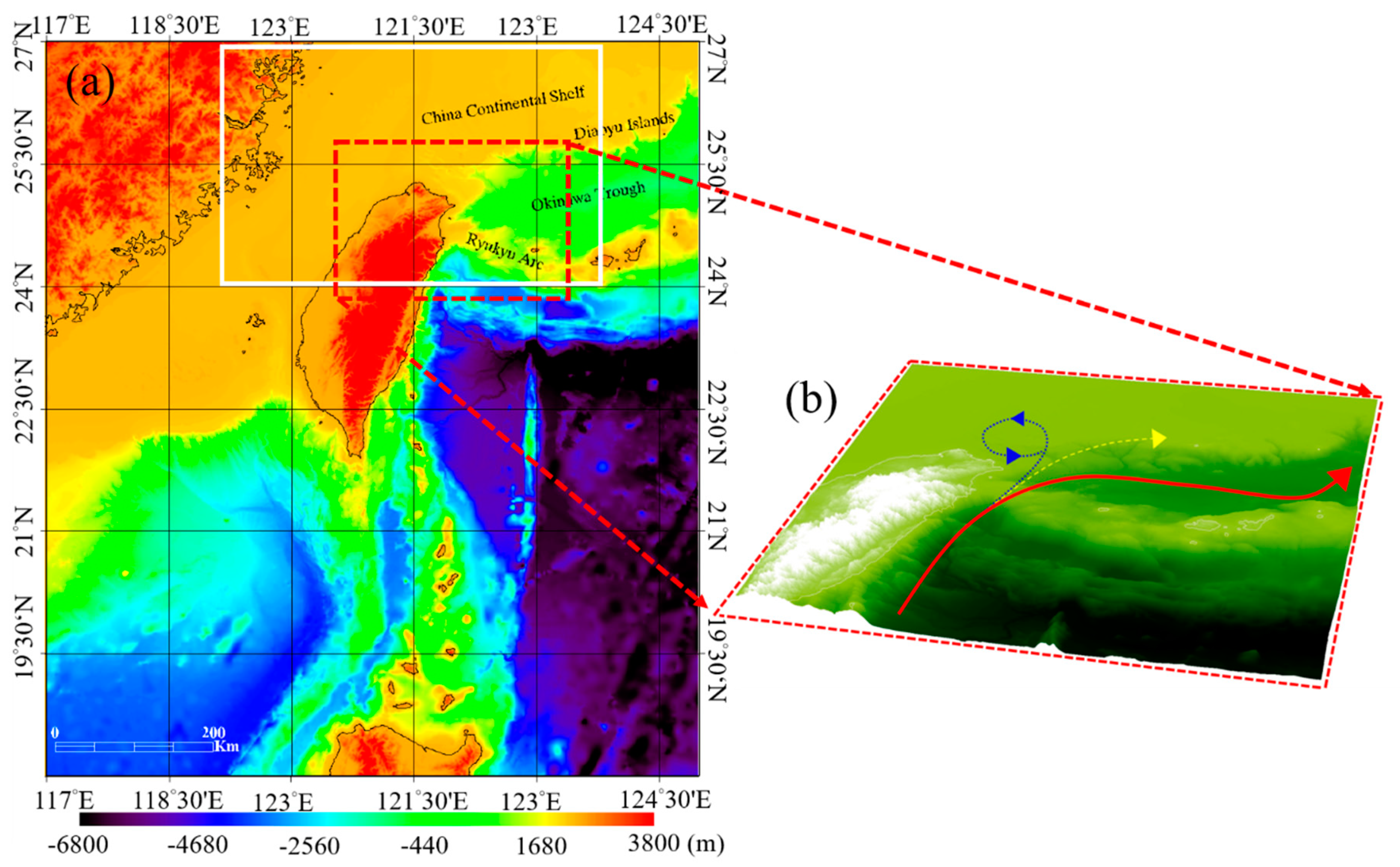
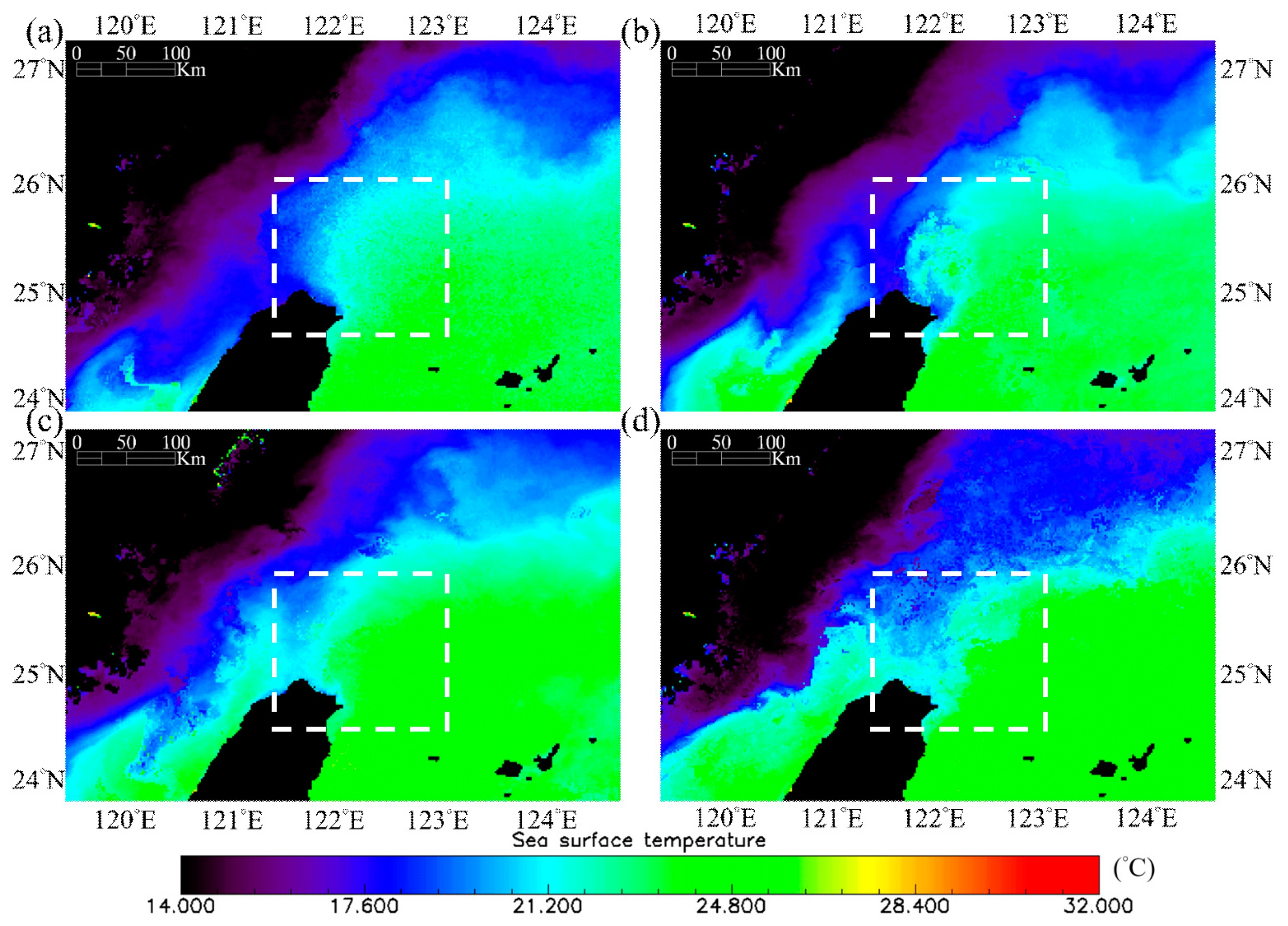

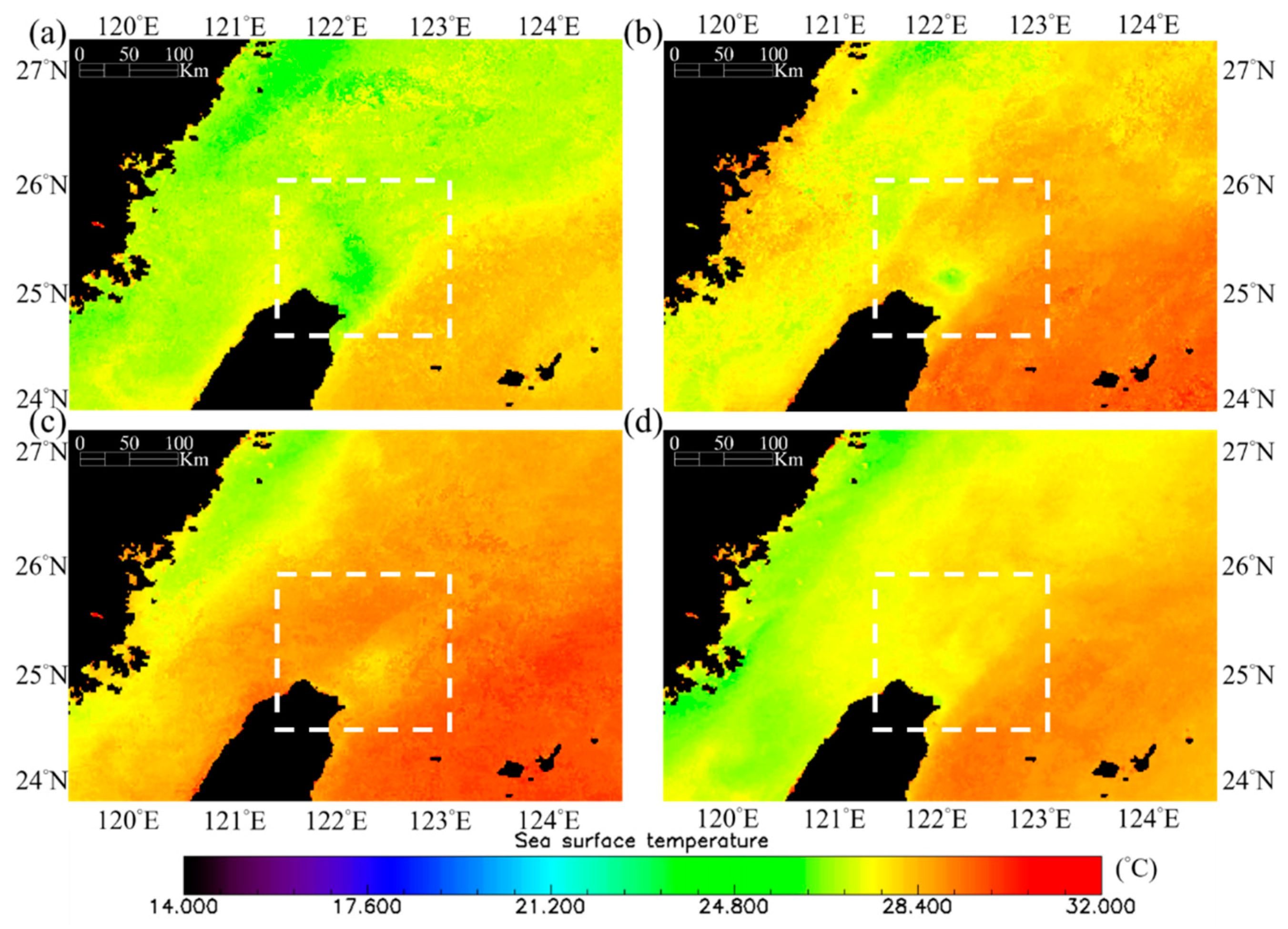
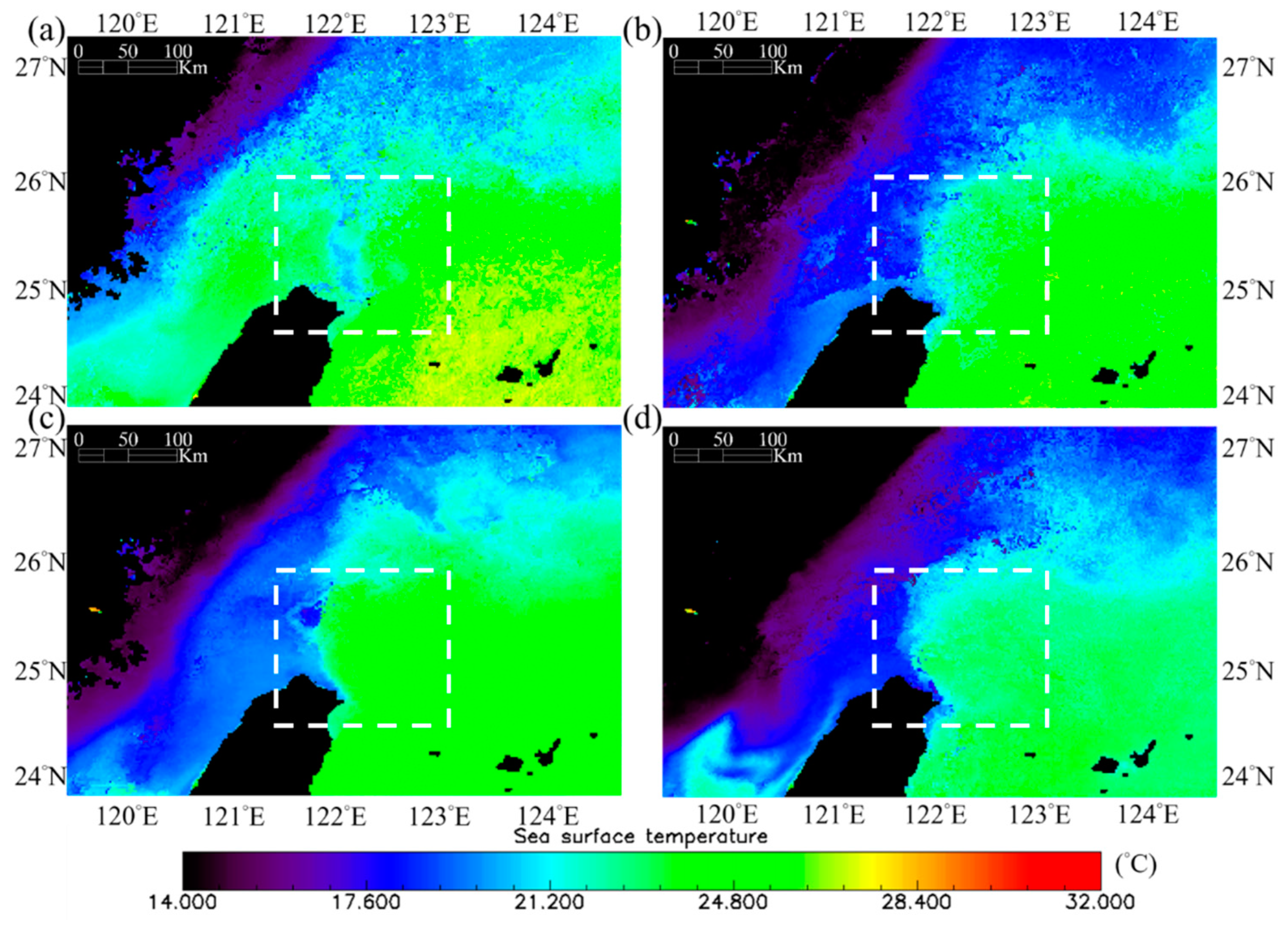
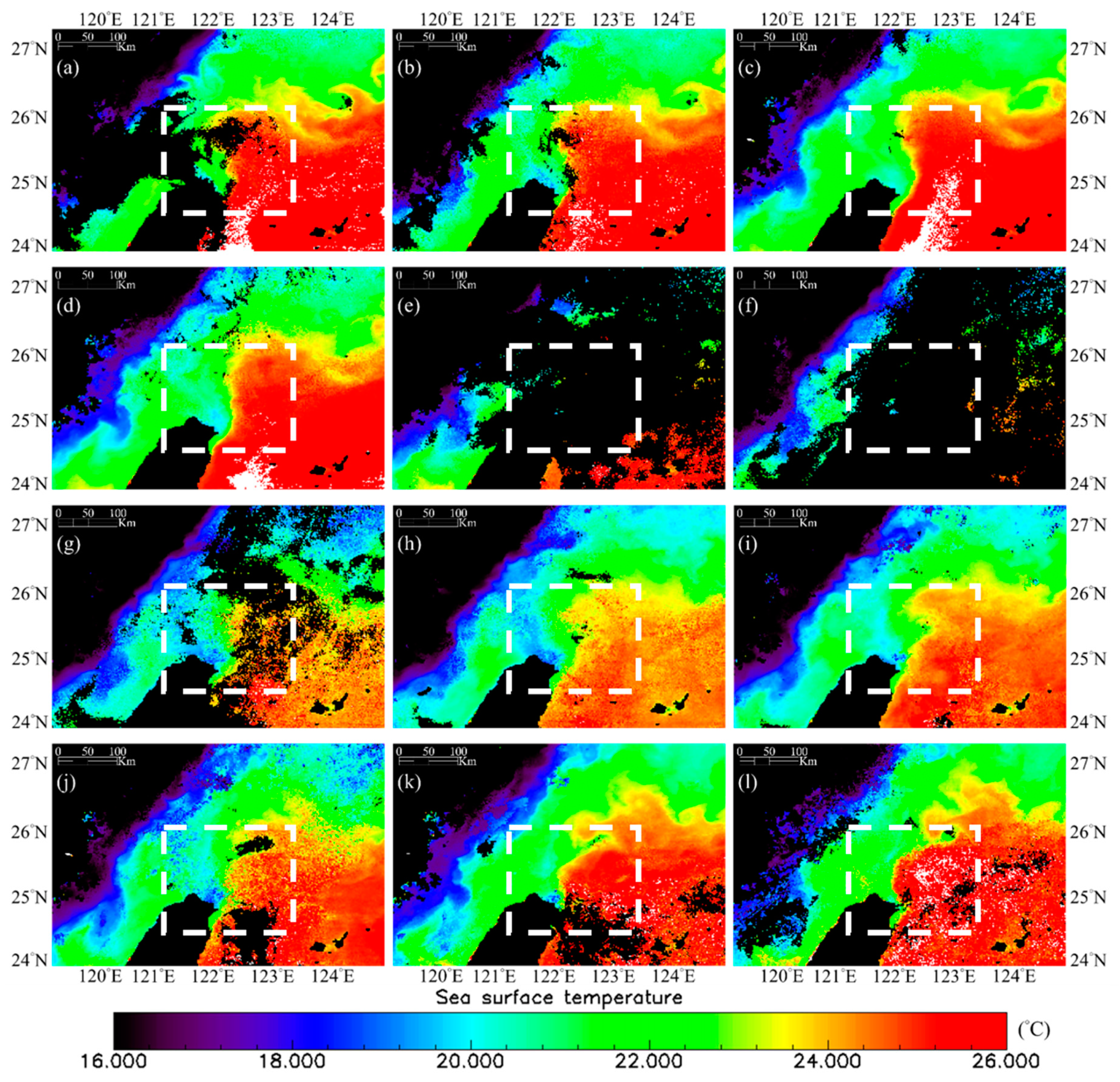
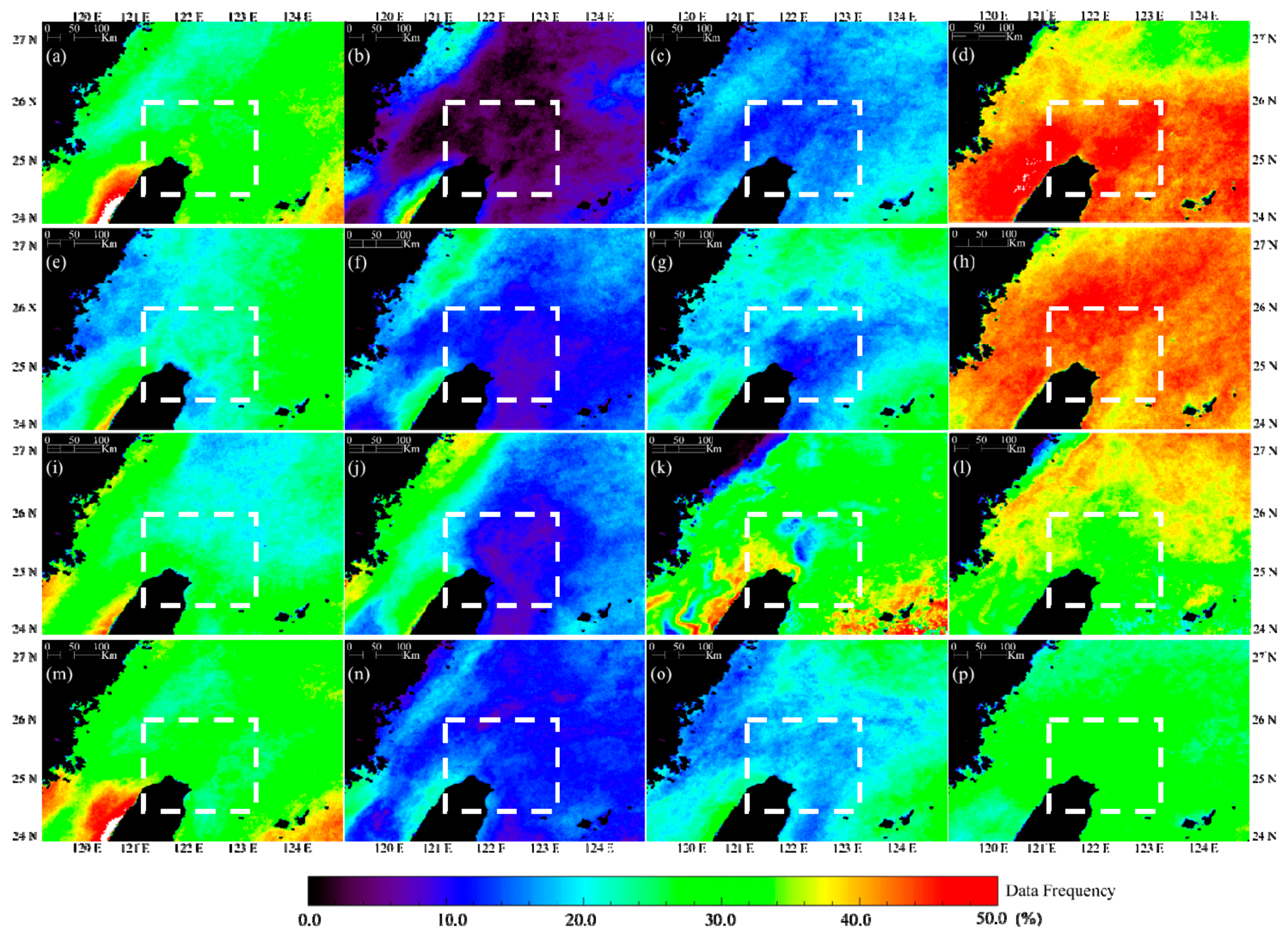

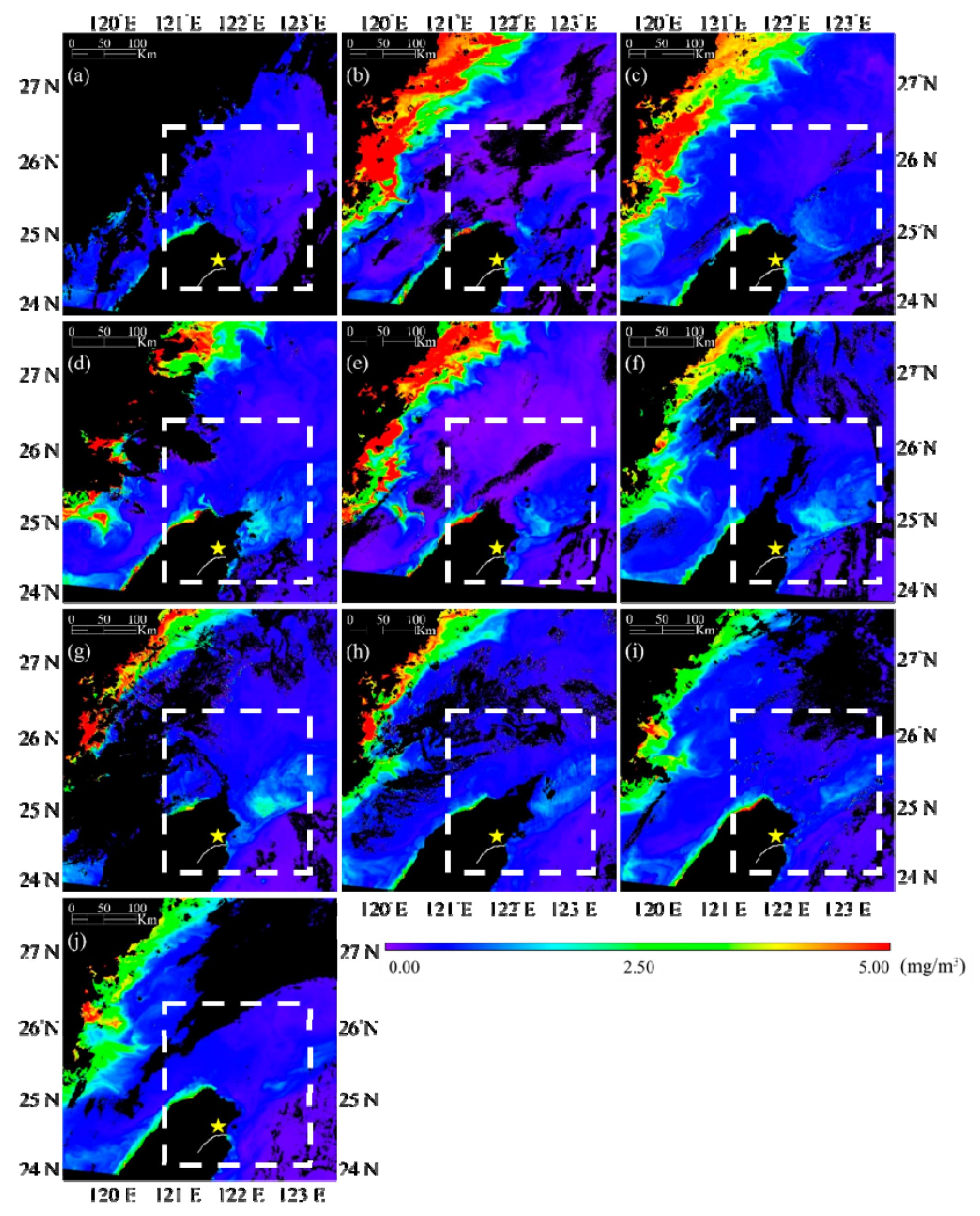
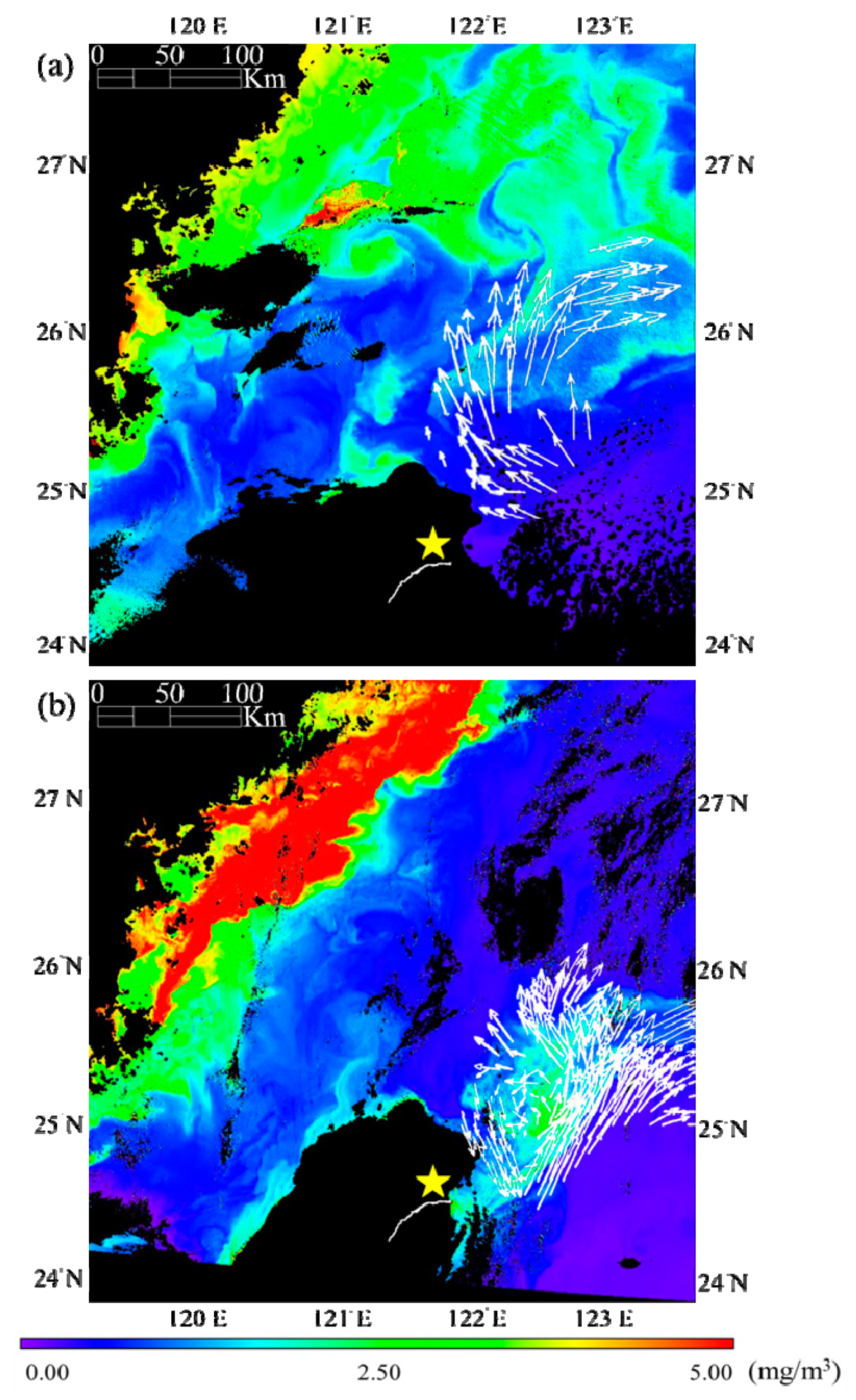

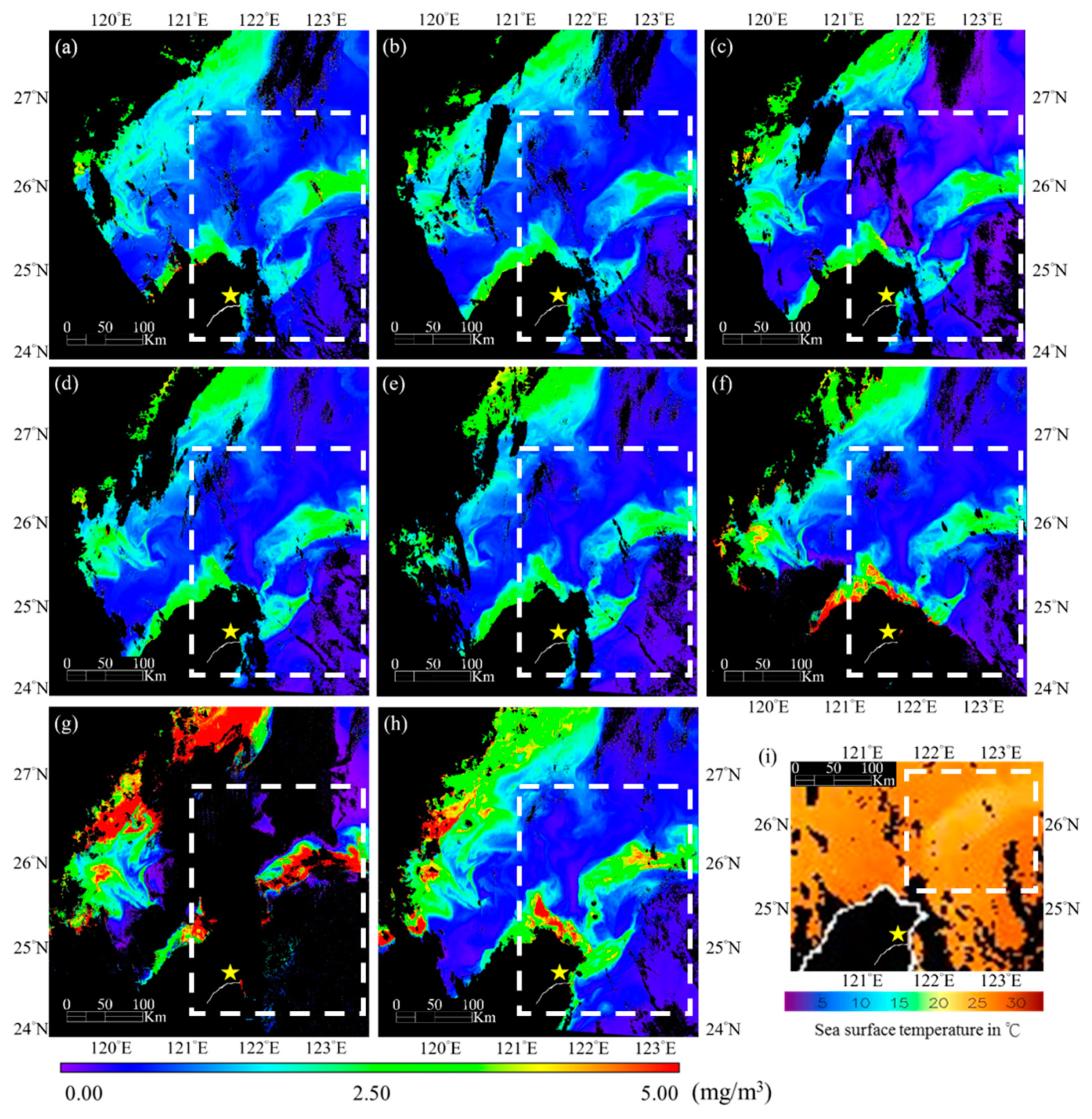
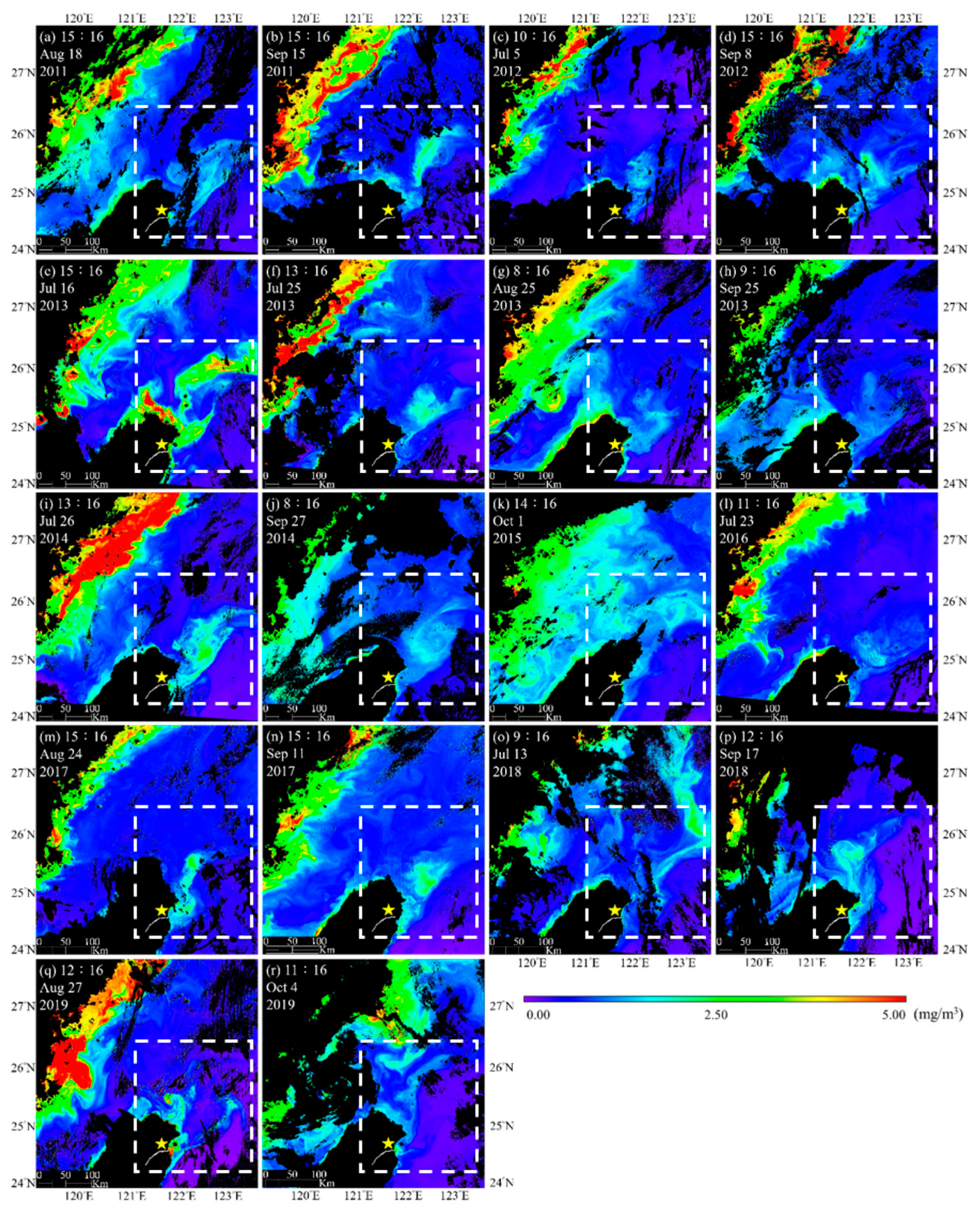

| Band | Center | Resolution | Primary Use |
|---|---|---|---|
| B1 | 0.47 μm | 1 km | Aerosol over land, coastal water, composite imaging |
| B2 | 0.51 μm | 1 km | Composite imaging |
| B3 | 0.64 μm | 0.5 km | Vegetation, burn scars, aerosol over water, winds, composite imaging |
| B4 | 0.86 μm | 1 km | Daytime cirrus clouds |
| B5 | 1.61 μm | 2 km | Daytime cloud-top phase & particle size, snow |
| B6 | 2.25 μm | 2 km | Daytime land/cloud properties, particle size, vegetation, snow |
| B7 | 3.89 μm | 2 km | Surface and cloud, fog at night, fire, and winds |
| B8 | 6.24 μm | 2 km | High-level atmospheric water vapor, winds, and rainfall |
| B9 | 6.94 μm | 2 km | Mid-level atmospheric water vapor, winds, and rainfall |
| B10 | 7.35 μm | 2 km | Lower-level atmospheric water vapor, winds, and SO2 |
| B11 | 8.59 μm | 2 km | Total water for stability, cloud phase, dust, SO2, and rainfall |
| B12 | 9.64 μm | 2 km | Total ozone, turbulence, and winds |
| B13 | 10.41 μm | 2 km | Surface and cloud |
| B14 | 11.24 μm | 2 km | Imagery, sea surface temperature, clouds, and rainfall |
| B15 | 12.38 μm | 2 km | Total water, ash, and sea surface temperature |
| B16 | 13.28 μm | 2 km | Air temperature, cloud heights and amounts |
| Band | Center | Width | SNR | Primary Use |
|---|---|---|---|---|
| B1 | 412 nm | 20 nm | 1077 | Yellow substance and turbidity |
| B2 | 443 nm | 20 nm | 1199 | Chlorophyll absorption maximum |
| B3 | 490 nm | 20 nm | 1316 | Chlorophyll and other pigments |
| B4 | 555 nm | 20 nm | 1223 | Turbidity, suspended sediment |
| B5 | 660 nm | 20 nm | 1192 | Baseline of fluorescence signal, chlorophyll, suspended sediment |
| B6 | 680 nm | 10 nm | 1093 | Atmospheric correction and fluorescence signal |
| B7 | 745 nm | 20 nm | 1107 | Atmospheric correction and baseline of fluorescence signal |
| B8 | 865 nm | 40 nm | 1009 | Aerosol optical thickness, vegetation, water vapor reference over the ocean |
| Typhoon | Warnings | Image Date | Corresponding Figure Number in Figure 13 |
|---|---|---|---|
| 2011 Muifa | 4 to 6 August | 15:16 on 18 August 2011 | (a) |
| 2011 Nanmadol | 27 to 31 August | 15:16 on 15 September 2011 | (b) |
| 2012 Doksuri | 28 to 29 June | 12:16 on 7 July 2012 | (c) |
| 2012 Tembin | 21 to 28 August | 15:16 on 8 September 2012 | (d) |
| 2013 Soulik | 11 to 13 July | 15:16 on 16 July 2013 | (e) |
| 2013 Cimaron | 17 to 18 July | 13:16 on 25 July 2013 | (f) |
| 2013 Trami | 20 to 22 August | 8:16 on 25 August 2013 | (g) |
| 2013 Usagi | 19 to 22 September | 9:16 on 25 September 2013 | (h) |
| 2014 Matmo | 21 to 23 July | 13: 16 on 26 July 2014 | (i) |
| 2014 Fung-Wong | 19 to 22 September | 8:16 on 27 September 2014 | (j) |
| 2015 Dujuan | 27 to 29 September | 14:16 on 1 October 2015 | (k) |
| 2016 Nepartak | 6 to 9 July | 11:16 on 23 July 2016 | (l) |
| 2017 Hato | 20 to 22 August | 15:16 on 24 August 2017 | (m) |
| 2017 Guchol | 6 to 7 September | 15:16 on 11 September 2017 | (n) |
| 2018 Maria | 9 to 11 July | 9:16 on 13 July 2018 | (o) |
| 2018 Mangkhut | 14 to 15 September | 12:16 on 17 September 2018 | (p) |
| 2019 Bailu | 23 to 25 August | 12:16 on 27 August 2019 | (q) |
| 2019 Mitag | 29 September to 1 October | 11:16 on 4 October 2019 | (r) |
© 2019 by the authors. Licensee MDPI, Basel, Switzerland. This article is an open access article distributed under the terms and conditions of the Creative Commons Attribution (CC BY) license (http://creativecommons.org/licenses/by/4.0/).
Share and Cite
Chung, H.-W.; Liu, C.-C. Spatiotemporal Variation of Cold Eddies in the Upwelling Zone off Northeastern Taiwan Revealed by the Geostationary Satellite Imagery of Ocean Color and Sea Surface Temperature. Sustainability 2019, 11, 6979. https://doi.org/10.3390/su11246979
Chung H-W, Liu C-C. Spatiotemporal Variation of Cold Eddies in the Upwelling Zone off Northeastern Taiwan Revealed by the Geostationary Satellite Imagery of Ocean Color and Sea Surface Temperature. Sustainability. 2019; 11(24):6979. https://doi.org/10.3390/su11246979
Chicago/Turabian StyleChung, Hsiao-Wei, and Cheng-Chien Liu. 2019. "Spatiotemporal Variation of Cold Eddies in the Upwelling Zone off Northeastern Taiwan Revealed by the Geostationary Satellite Imagery of Ocean Color and Sea Surface Temperature" Sustainability 11, no. 24: 6979. https://doi.org/10.3390/su11246979
APA StyleChung, H.-W., & Liu, C.-C. (2019). Spatiotemporal Variation of Cold Eddies in the Upwelling Zone off Northeastern Taiwan Revealed by the Geostationary Satellite Imagery of Ocean Color and Sea Surface Temperature. Sustainability, 11(24), 6979. https://doi.org/10.3390/su11246979






